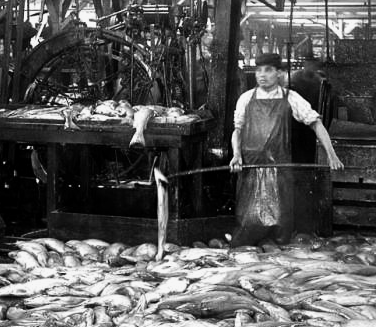Edmund A. Smith (inventor) on:
[Wikipedia]
[Google]
[Amazon]
Edmund Augustine "Ned" Smith (March 17, 1870 – June 3, 1909) was an American entrepreneur and inventor who helped to industrialize the fish packing and canning industry.
 Smith's invention severely impacted the workers of the seafood industry, forcing thousands of seafood butchers and packers to find other sources of employment. However, Smith's invention increased cannery profits and led to the growth of the seafood industry.
Smith's invention gave him considerable wealth. Smith was invited to display his invention at the Alaska–Yukon–Pacific Exposition in 1909.
Smith's invention severely impacted the workers of the seafood industry, forcing thousands of seafood butchers and packers to find other sources of employment. However, Smith's invention increased cannery profits and led to the growth of the seafood industry.
Smith's invention gave him considerable wealth. Smith was invited to display his invention at the Alaska–Yukon–Pacific Exposition in 1909.
Early life
Smith was born in 1870 inMiddlesex County, Ontario
Middlesex County (2016 population 71,551)Sum of the eight municipalities in Middlesex County from is a primarily rural county in Southwestern Ontario, Canada. Landlocked, the county is bordered by Huron and Perth counties on the north, Oxford Co ...
, the son of Robert Frederick Smith (1832–1916) and Mary Charlotte Garnett Smith (1845–1899) By 1895, Smith had moved to Seattle, Washington.
Career
Smith was an investor in various fish canning and brick-making businesses in the Seattle area. He owned the Smith Manufacturing Company, a waterfront workshop in the city where he developed and manufactured various inventions. In 1903, Smith invention a mechanized fish-butchering machine which he named the ''Iron Chink
''Chink'' is an English-language ethnic slur usually referring to a person of Chinese descent. The word is also sometimes indiscriminately used against people of East Asian, North Asian and Southeast Asian appearance. The use of the term ...
,'' which gutted and cleaned salmon for canning at a rate of 55 times faster than human butchers. Smith obtained a U.S. patent for the machine in 1905 and a patent in Canada the following year. Other patented inventions of Smith's included a weight testing machine and composite pile.
The naming of the machine is seen by some as symbolic anti-Chinese racism during the early 1900s The 1900s may refer to:
* 1900s (decade), the decade from 1900 to 1909
* The century from 1900 to 1999, almost synonymous with the 20th century
The 20th (twentieth) century began on
January 1, 1901 ( MCMI), and ended on December 31, 2000 ( MM ...
. However, some historians have held that Smith named the machine due to his regard for Chinese butcher crews.
 Smith's invention severely impacted the workers of the seafood industry, forcing thousands of seafood butchers and packers to find other sources of employment. However, Smith's invention increased cannery profits and led to the growth of the seafood industry.
Smith's invention gave him considerable wealth. Smith was invited to display his invention at the Alaska–Yukon–Pacific Exposition in 1909.
Smith's invention severely impacted the workers of the seafood industry, forcing thousands of seafood butchers and packers to find other sources of employment. However, Smith's invention increased cannery profits and led to the growth of the seafood industry.
Smith's invention gave him considerable wealth. Smith was invited to display his invention at the Alaska–Yukon–Pacific Exposition in 1909.
Personal life and death
Smith married Wisconsin native Mary Gertrude Peterson in 1898. They had two children, Helen (b. 1899) and Wallace (b. 1902). In June 1909 at the age of 39, Smith died in an automobile accident on his way to the opening of the Alaska–Yukon–Pacific Exposition. He is buried at Lake View Cemetery in Seattle.Legacy
An exhibit about Smith, including his "Iron Chink" invention, is displayed at the Museum of History & Industry. Smith's invention is still used today, now known as the "Iron Butcher." His invention is regarded as an influential contribution to the growth of the warehousing, shipping, packing, and other cannery activities of the modern seafood industry, especially the salmon canning industry.References
{{DEFAULTSORT:Smith, Edmund A. 1870 births 1909 deaths 20th-century American businesspeople American fishers American food industry businesspeople Inventors from Washington (state) Businesspeople from Seattle People from Middlesex County, Ontario Businesspeople from Ontario Canadian emigrants to the United States Road incident deaths in Washington (state) Burials at Lake View Cemetery (Seattle)